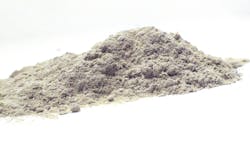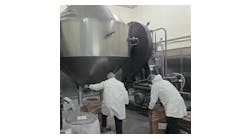Industrial clays such as bentonite, kaolin and the like are some of the most universal materials in modern society, employed in products all around us, from paints and refractories to fertilizers and cat litter, and so much more.
The processes and equipment used to turn mined clay into such products are nearly just as diverse, but one piece of equipment seems to find its way into many finishing and intermediate processes, no matter what the end goal: the industrial mixer, and in certain instances, the pin mixer.
What follows is an overview on how pin mixers are employed in bringing industrial clay products to market, as well as some of the challenges these mixers face, and how producers can work around them through thoughtful mixer design.
Applications
The list of applications for industrial clays is nearly endless; clays find innumerable uses as fillers, substrates, coatings, carriers, binders and additives.
Like clay, pin mixers are also incredibly diverse in their applicability, making them a perfect fit for processing clay in various types of operations. Unlike many industrial mixers that are capable of only one task, pin mixers are able to achieve several different objectives, from simple mixing, to producing a market-ready granular product.
These objectives can be broadly split into two categories: pretreating clays for subsequent processing and producing a finished product.
Pretreating clays for subsequent processing
Clays are frequently combined with additional solid and liquid components to reach a desired chemical composition and physical makeup prior to further processing.
In these settings, pin mixers are ideal for producing a homogeneous blend of solid and liquid feed components to achieve a uniform feedstock for downstream processing.
In addition to producing a homogeneous mixture, specific parameters such as moisture content, particle size and bulk density may also be met through processing in the pin mixer, ensuring downstream equipment has a feedstock ideally suited to its requirements.
This is frequently seen in pelletizing operations, where pin mixers are used to not only mix powdered clay and other dry components with a binding agent, but also to produce seed pellets for further growth on a disc pelletizer or other agglomeration device. Finished pellets may be used as adsorbent, absorbent, fertilizer, soil amendment or otherwise.
Producing a finished product
Apart from serving as a means of pretreatment, pin mixers are also capable of producing a market-ready product thanks to their particle size enlargement capabilities.
Beyond producing a homogeneous mixture, pin mixers can produce everything from a wet fluff to agglomerates. This makes them ideal for producing micro pellets such as those used in kitty litter and catalyst applications, as well as slightly larger agglomerates often preferred in soil amendment and fertilizer applications.
Here again, producers have some ability to hone in on specific parameters such as particle size, bulk density, crush strength and more, by making changes to variables such as spray locations, binder feed rate, solids feed rate, pin arrangement, rotor speed and more.
Clay mixing challenges
Despite its ubiquity, clay is not without its challenges; the many qualities that make clay effective in so many applications can also make it challenging to work with, requiring special attention to mixer design.
While all clays are different, they all exhibit two primary problems to varying degrees: their sticky quality and substantial variation.
Stickiness
Clay has a sticky quality that can make processing a challenge. In the pin mixer, this can present itself as a clogged feed or discharge chute (clogging in the feed area is most common), as well as buildup both in and around the mixer, which brings its own set of problems. It can also put additional strain on the mixer’s motor.
When producing granules, stickiness can also promote the formation of “raspberries,” which occurs when granules stick together, forming clumps of pellets.
Clay may also become sticky during processing. This happens because clays tend to hold their free moisture in the interstitial spaces between particles. When clay undergoes processing that pushes these particles together, the water content is forced to the surface of the particles, causing the clay to become newly tacky with an exterior layer of moisture.
Addressing stickiness through mixer design
Preventing clay from sticking in the mixer can be challenging, but there are several opportunities to minimize its potential through mixer design.
Evaluate chute configuration: Feed and discharge chutes must be carefully configured, avoiding steep angles, utilizing a UHMW liner and incorporating a rodding port so material may be dislodged in the event that sticking occurs.
Carefully select drive components: The mixer’s motor and reducer must be adequately powered to handle the amperage load that a sticky material can put on them, with higher horsepower being essential. A variable frequency drive (VFD) can be especially helpful in clay mixing settings as well, giving operators the ability to adjust motor speed in response to changes in production, as well as at startup and shutdown.
Optimize spray system design: The mixer’s spray system should also be designed for flexibility. The use of multiple injection ports can give operators options for moisture addition in response to changing conditions. Proper nozzle type, spray locations, number of spray locations and liquid feed rate, must all be carefully balanced to achieve the desired result. The ability to accurately meter and properly distribute liquid components into the mixer is critical to smooth and consistent operation.
Consider mixer shaft and trough design: The mixer shaft and trough should also be configured with clay’s sticky quality in mind. This may mean installing a polished liner or fabricating the mixer from stainless steel, as well as incorporating features such as a self-raising cover for easy cleanout to keep buildup to a minimum. Pin arrangement can also be designed to discourage sticking; by arranging pins closely together, they are able to “clean” the interior of the housing (large gaps between pins create the potential for material to build up into a dam). Joins should be limited, and any welds ground smooth to prevent places on which material could catch and begin to accumulate.
Variability
Clay varies significantly, not just across types, but even within the same deposit. Both chemical composition and physical specifications can vary widely, making clay’s processing behavior for any given source difficult to predict.
This makes developing a familiarity with the specific clay source and its potential for variation essential.
Addressing variation through mixer design
The best way to account for variation is through thorough feasibility testing and process development. The specified clay source should be tested on a continuous scale to establish the full range of potential variation and how best to accommodate fluctuating conditions when they arise.
Testing in a facility such as The FEECO Innovation Center gives producers an opportunity to become familiar with their specific source of clay and how it responds to the intended processing.
Further, testing on a continuous scale helps to predict potential issues in scale-up, as well as define process data points such as retention time, solid and liquid feed rates, mixer speed and more.
Conclusion
The diversity of clay’s applications in modern industry relies heavily on the ability to process the material to meet desired specifications, in which the pin mixer is ideal for meeting the industry’s varied objectives.
Clay’s sticky nature and its tendency for variation can make consistent processing a challenge, even in a mixer with capabilities as diverse as the pin mixer’s. Fortunately, producers have several options available to them to address these challenges through mixer design, with thorough testing being a critical component.
Producers should also take care to work with a mixer manufacturer already familiar with the challenges clay can bring, allowing them to design a mixer uniquely suited for the source of clay.
Chris Kozicki is a process sales engineer specializing in tumble-growth agglomeration and has been with FEECO for over 30 years. Kozicki is an active member of the agglomeration community and former president of the Institute for Briquetting and Agglomeration (IBA).
Carrie Carlson is a technical writer who has been with FEECO for over a decade. She works closely with engineers and process experts to turn complex ideas into easy-to-understand literature.





